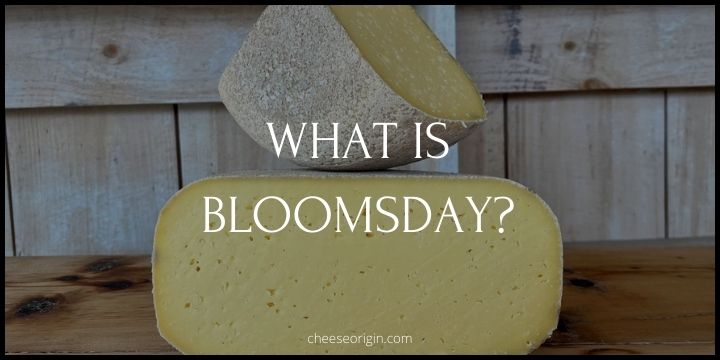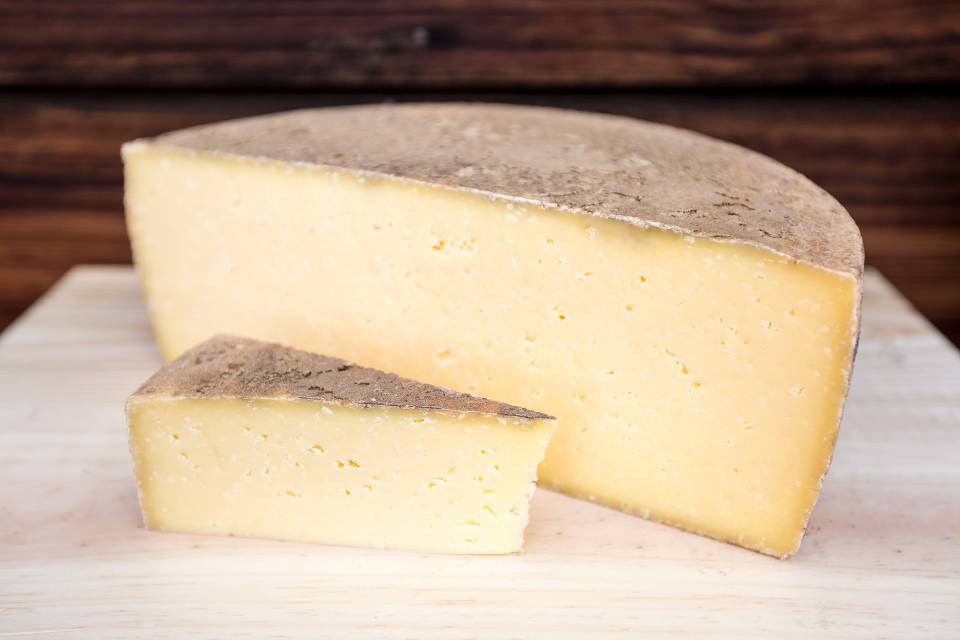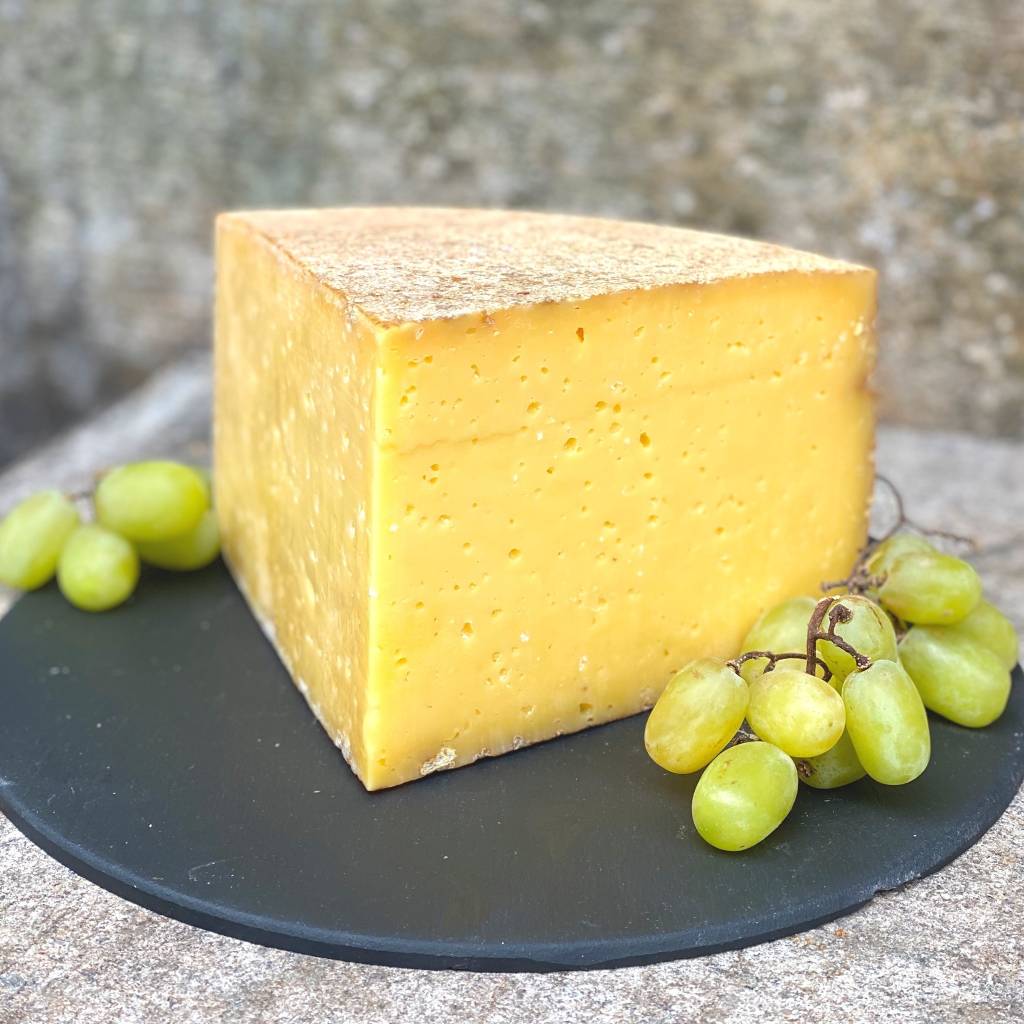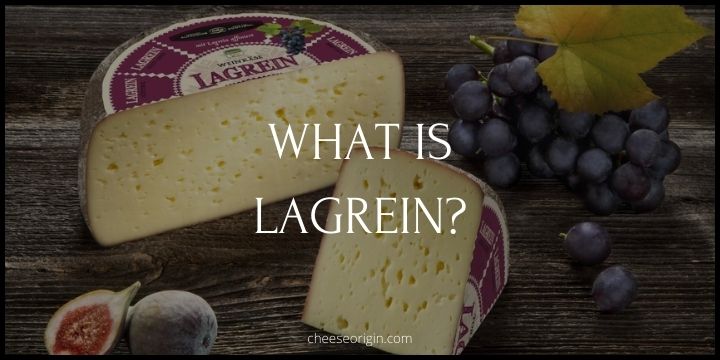What is Bloomsday? A Taste of Artisanal Mastery

Nestled in the heart of Connecticut at Cato Corner Farm, Bloomsday is a testament to the art of cheese-making. This revered cheese, named after James Joyce’s famous novel “Ulysses,” is a culinary masterpiece that has won over cheese enthusiasts worldwide.
Aged for up to a year, Bloomsday Cheese boasts a complex profile – a robust, nutty flavor coupled with a subtle sweetness and a creamy yet firm texture. Each bite is a savory journey, transporting you to the lush, green pastures where it all begins.
Quick Facts About Bloomsday
| Quick Facts | Bloomsday Cheese |
|---|---|
| Origin | Connecticut, USA |
| Milk Type | Raw Cow’s Milk |
| Texture | Creamy, Firm |
| Flavor | Nutty, Slightly Sweet |
| Ageing | 10-14 Months |
| Pairings | Red Wines, Dark Beers |
| Named After | ‘Bloomsday’, Joyce’s ‘Ulysses’ |
| Unique Feature | Cider-Washed |
| Awards | ACS – 2nd Place (2014, 2015) |
| Availability | Year-round |
What is Bloomsday?

Bloomsday cheese is a delightful creation that has captivated cheese lovers with its distinctive qualities. This artisanal cheese owes its name to James Joyce’s ‘Ulysses’, further cementing its unique position in the world of gourmet cheeses.
Produced by Cato Corner Farm, one of America’s pioneering artisan cheese manufacturers, Bloomsday is crafted from raw cow’s milk. It carries a flavor profile reminiscent of a good young cheddar, making it a versatile addition to any cheese plate.
What sets Bloomsday apart is its texture and taste. It’s drier than many other varieties and features a fabulous nutty flavor. The lingering aftertaste is addictive, inviting you to enjoy just one more bite.
Aged Bloomsday, which matures for 11-12 months, offers a sharper and more intense finish. The aging process lends it a cheddar-like bite, balanced by a hint of sweetness. During the extra months in the cave, these special wheels of Bloomsday get drier and slightly crystalline, while developing a sharp, cheddar-y finish.
Bloomsday cheese is a testament to the art of cheese-making, embodying a perfect balance of flavors and textures. Whether you’re a seasoned cheese connoisseur or a casual foodie, Bloomsday will leave a lasting impression.
What Does Bloomsday Taste Like?
Bloomsday cheese is a luxurious treat for the taste buds. It boasts a flavor profile reminiscent of fresh hand-churned butter, making it a delightfully creamy and rich cheese.
As the cheese matures, it develops an even more intriguing flavor. The aged Bloomsday, which is allowed to mature for 11-12 months, offers a sharper and more intense finish. This version of the cheese is known for its cheddar-like bite that’s perfectly balanced by a touch of sweetness.
Whether enjoyed on a cheese board or melted into a dish of mac n’ cheese, Bloomsday’s unique taste ensures it holds a special place in any cheese lover’s heart.
Bloomsday Tasting Notes
- Flavor Start: Begins with a mild, creamy taste, akin to fresh butter
- Maturation: Develops a nutty profile as it matures
- Aged Quality: Aged Bloomsday offers a cheddar-like bite
- Sweetness: Balanced by a subtle hint of sweetness
- Texture: Exhibits a slightly crystalline texture when aged
- Aftertaste: Leaves a lingering, addictive aftertaste
- Pairing: Pairs well with robust red wines and crisp apple slices
10 Best Bloomsday Substitutes
| Substitute | Description |
|---|---|
| Cheddar | A widely available cheese with a sharp, mature flavor similar to aged Bloomsday. |
| Gruyère | Swiss cheese known for its nutty, slightly sweet taste. It melts well, making it a good substitute in recipes. |
| Manchego | Spanish cheese made from sheep’s milk. It has a firm texture and a flavor that balances sweetness and saltiness. |
| Comté | French cheese with a complex, nutty flavor profile. It’s versatile and can be used in various dishes. |
| Colby | An American semi-hard cheese with a mild flavor. It’s less sharp than Bloomsday but can work as a substitute in many recipes. |
| Monterey Jack | Another American cheese, known for its mild flavor and excellent melting properties. |
| Havarti | Danish cheese that is buttery, slightly acidic, and great for melting. |
| Emmental | Swiss cheese with a mild, slightly nutty flavor. It’s known for its distinctive holes and excellent melting quality. |
| Jarlsberg | Norwegian cheese with a sweet, nutty flavor. It’s semi-soft and melts well. |
| Gouda | Dutch cheese that ranges in flavor from mild to sharp, depending on age. Its versatility makes it a good substitute for Bloomsday. |
What Pairs Well With Bloomsday?

Food that goes well with Bloomsday:
| Category | Food Pairing |
|---|---|
| Fruits | Apples, pears, figs, and grapes. These fruits provide a sweet contrast to the nutty, mature flavor of Bloomsday. |
| Nuts | Almonds, walnuts, and pecans. Their crunch and slight bitterness complement the creamy texture and flavor of the cheese. |
| Breads | Crusty baguettes, multigrain bread, and rye crackers. They provide a textural contrast and a neutral base to highlight the cheese. |
| Meats | Charcuterie such as prosciutto, salami, and chorizo. The saltiness and umami of these meats balance the cheese’s richness. |
| Condiments | Honey, fig jam, and whole grain mustard. These can add sweetness or tanginess to create a more complex flavor profile. |
| Vegetables | Marinated olives, roasted red peppers, and pickled gherkins. They provide a tangy contrast to the cheese’s creaminess. |
| Seafood | Smoked salmon or anchovies. Their salty, briny flavors pair well with the cheese’s nuttiness. |
| Desserts | Dark chocolate or fruit tarts. The sweetness of these desserts can complement the savory, mature flavor of Bloomsday. |
Also read: What Fruit Goes on a Charcuterie Board?
Beverage that goes well with Bloomsday:
| Category | Beverage Pairing |
|---|---|
| Wines | Robust red wines like Cabernet Sauvignon or Merlot, or white wines like Chardonnay or Sauvignon Blanc. These wines have the body and complexity to stand up to the rich flavor of Bloomsday. |
| Beers | Pale ales, IPAs, and Belgian-style beers. Their bitterness can balance the creaminess of the cheese. |
| Spirits | Whiskey, particularly Scotch or Irish whiskey. Their smoky, caramel notes complement the nutty flavor of Bloomsday. |
| Non-Alcoholic | Sparkling water, apple cider, or grape juice. They provide a refreshing contrast to the cheese’s richness. |
| Ciders | Dry apple or pear ciders. Their tartness and effervescence can cut through the cheese’s creaminess. |
| Port/Dessert Wines | Tawny port or Sauternes. Their sweetness contrasts nicely with the savory, mature flavor of Bloomsday. |
| Coffee/Tea | Strong black coffee or robust teas like Earl Grey or Darjeeling. Their bitterness and tannins can balance the cheese’s richness. |
Also read: Best Wine and Cheese Pairings: The Ultimate Guide
Also read:
- What is Tomme Crayeuse? The Chalky Delight from Savoie
- What is Chloro Cheese? The Taste of Santorini
- 5 Most Popular Cheeses Originated in Portugal
- 10 Most Popular Goat Milk Cheeses in the World
- What is Majorero? Spain’s Nutty Cheese Treasure
- What is Tetilla Cheese? Galicia’s Signature Cheese
- What is Pata Cabra Cheese? A Taste of Spain’s Goat Milk Mastery





